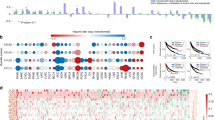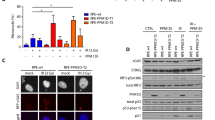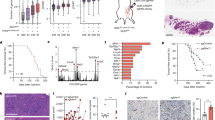Abstract
During the evolution of cancer, the incipient tumour experiences ‘oncogenic stress’, which evokes a counter-response to eliminate such hazardous cells. However, the nature of this stress remains elusive, as does the inducible anti-cancer barrier that elicits growth arrest or cell death. Here we show that in clinical specimens from different stages of human tumours of the urinary bladder, breast, lung and colon, the early precursor lesions (but not normal tissues) commonly express markers of an activated DNA damage response. These include phosphorylated kinases ATM and Chk2, and phosphorylated histone H2AX and p53. Similar checkpoint responses were induced in cultured cells upon expression of different oncogenes that deregulate DNA replication. Together with genetic analyses, including a genome-wide assessment of allelic imbalances, our data indicate that early in tumorigenesis (before genomic instability and malignant conversion), human cells activate an ATR/ATM-regulated DNA damage response network that delays or prevents cancer. Mutations compromising this checkpoint, including defects in the ATM–Chk2–p53 pathway, might allow cell proliferation, survival, increased genomic instability and tumour progression.
This is a preview of subscription content, access via your institution
Access options
Subscribe to this journal
Receive 51 print issues and online access
$199.00 per year
only $3.90 per issue
Buy this article
- Purchase on SpringerLink
- Instant access to full article PDF
Prices may be subject to local taxes which are calculated during checkout






Similar content being viewed by others
References
Lowe, S. W., Cepero, E. & Evan, G. I. Intrinsic tumour suppression. Nature 432, 307–315 (2004)
Lengauer, C., Kinzler, K. W. & Vogelstein, B. Genetic instabilities in human cancers. Nature 396, 643–649 (1998)
Graeber, T. G. et al. Hypoxia induces accumulation of p53 protein, but activation of a G1-phase checkpoint by low-oxygen conditions is independent of p53 status. Mol. Cell. Biol. 14, 6264–6277 (1994)
Counter, C. M. et al. Telomere shortening associated with chromosome instability is arrested in immortal cells which express telomerase activity. EMBO J. 11, 1921–1929 (1992)
Zindy, F. et al. Arf tumour suppressor promoter monitors latent oncogenic signals in vivo . Proc. Natl Acad. Sci. USA 100, 15930–15935 (2003)
Vogelstein, B., Lane, D. & Levine, A. J. Surfing the p53 network. Nature 408, 307–310 (2000)
DiTullio, R. A. Jr et al. 53BP1 functions in an ATM-dependent checkpoint pathway that is constitutively activated in human cancer. Nature Cell Biol. 4, 998–1002 (2002)
Lukas, C., Falck, J., Bartkova, J., Bartek, J. & Lukas, J. Distinct spatiotemporal dynamics of mammalian checkpoint regulators induced by DNA damage. Nature Cell Biol. 5, 255–260 (2003)
Kastan, M. B. & Bartek, J. Cell-cycle checkpoints and cancer. Nature 432, 316–323 (2004)
Shiloh, Y. ATM and related protein kinases: safeguarding genome integrity. Nature Rev. Cancer 3, 155–168 (2003)
Vafa, O. et al. c-Myc can induce DNA damage, increase reactive oxygen species, and mitigate p53 function: a mechanism for oncogene-induced genetic instability. Mol. Cell 9, 1031–1044 (2002)
Lindström, M. S. & Wiman, K. G. Myc and E2F1 induce p53 through p14ARF-independent mechanisms in human fibroblasts. Oncogene 22, 4993–5005 (2003)
Bakkenist, C. J. & Kastan, M. B. DNA damage activates ATM through intermolecular autophosphorylation and dimer dissociation. Nature 421, 499–506 (2003)
Rogakou, E. P., Pilch, D. R., Orr, A. H., Ivanova, V. S. & Bonner, W. M. DNA double-stranded breaks induce histone H2AX phosphorylation on serine 139. J. Biol. Chem. 273, 5858–5868 (1998)
Lindblad-Toh, K. et al. Loss-of-heterozygosity analysis of small-cell lung carcinomas using single-nucleotide polymorphism arrays. Nature Biotechnol. 18, 1001–1005 (2000)
Gorgoulis, V. G. et al. Activation of the DNA damage checkpoint and genomic instability in human precancercous lesions. Nature doi:10.1038/nature03485 (this issue)
Spruck, C. H., Won, K. A. & Reed, S. I. Deregulated cyclin E induces chromosome instability. Nature 401, 297–300 (1999)
Minella, A. C. et al. p53 and p21 form an inducible barrier that protects cells against cyclin E-cdk2 deregulation. Curr. Biol. 12, 1817–1827 (2002)
Ekholm-Reed, S. et al. Deregulation of cyclin E in human cells interferes with prereplication complex assembly. J. Cell Biol. 165, 789–800 (2004)
Reed, S. E. et al. Mutation of hCDC4 leads to cell cycle deregulation of cyclin E in cancer. Cancer Res. 64, 795–800 (2004)
Rajagopalan, H. et al. Inactivation of hCDC4 can cause chromosomal instability. Nature 428, 77–81 (2004)
Kim, S. T., Xu, B. & Kastan, M. B. Involvement of the cohesin protein, Smc1, in Atm-dependent and independent responses to DNA damage. Genes Dev. 16, 560–570 (2002)
Ward, I. M. & Chen, J. Histone H2AX is phosphorylated in an ATR-dependent manner in response to replicational stress. J. Biol. Chem. 276, 47759–47762 (2001)
Mailand, N. et al. Rapid destruction of human Cdc25A in response to DNA damage. Science 288, 1425–1429 (2000)
Cangi, M. G. et al. Role of the Cdc25A phosphatase in human breast cancer. J. Clin. Invest. 106, 753–761 (2000)
Müller, H. et al. E2Fs regulate the expression of genes involved in differentiation, development, proliferation, and apoptosis. Genes Dev. 15, 267–285 (2001)
Bartek, J., Bartkova, J. & Lukas, J. The retinoblastoma protein pathway in cell cycle control and cancer. Exp. Cell Res. 237, 1–6 (1997)
Zhao, H. & Piwnica-Worms, H. ATR-mediated checkpoint pathways regulate phosphorylation and activation of human Chk1. Mol. Cell. Biol. 21, 4129–4139 (2001)
Gatei, M. et al. ATM and NBS1-dependent phosphorylation of Chk1 on Ser-317 in response to ionizing radiation. J. Biol. Chem. 278, 14806–14811 (2003)
Bao, S. et al. ATR/ATM-mediated phosphorylation of human Rad17 is required for genotoxic stress responses. Nature 411, 969–974 (2001)
Resnitzky, D., Gossen, M., Bujard, H. & Reed, S. I. Acceleration of the G1/S phase transition by expression of cyclins D1 and E with an inducible system. Mol. Cell. Biol. 14, 1669–1679 (1994)
Santoni-Rugiu, E., Falck, J., Mailand, N., Bartek, J. & Lukas, J. Involvement of Myc activity in a G1/S-promoting mechanism parallel to the pRB/E2F pathway. Mol. Cell. Biol. 20, 3497–3509 (2000)
Bartek, J., Lukas, C. & Lukas, J. Checking on DNA damage in S phase. Nature Rev. Mol. Cell Biol. 5, 792–804 (2004)
Lew, D. J. & Kornbluth, S. Regulatory roles of cyclin dependent kinase phosphorylation in cell cycle control. Curr. Opin. Cell Biol. 8, 795–804 (1996)
Merrick, C. J., Jackson, D. & Diffley, J. F. X. Visualization of altered replication dynamics after DNA damage in human cells. J. Biol. Chem. 279, 20067–20075 (2004)
Zou, L. & Elledge, S. J. Sensing DNA damage through ATRIP recognition of RPA-ssDNA complexes. Science 300, 1542–1548 (2003)
Binz, S. K., Sheehan, A. M. & Wold, M. S. Replication protein A phosphorylation and the cellular response to DNA damage. DNA Repair (Amst.) 3, 1015–1024 (2004)
Walter, J. & Newport, J. Initiation of eukaryotic DNA replication: origin unwinding and sequential chromatin association of Cdc45, RPA and DNA polymerase α. Mol. Cell 5, 617–627 (2000)
Osborn, A. J., Elledge, S. J. & Zou, L. Checking on the fork: the DNA-replication stress-response pathway. Trends Cell Biol. 12, 509–516 (2002)
Tanaka, S. & Diffley, J. F. Deregulated G1-cyclin expression induces genomic instability by preventing efficient pre-RC formation. Genes Dev. 16, 2639–2649 (2002)
Lengronne, A. & Schwob, E. The yeast CDK inhibitor Sic1 prevents genomic instability by promoting replication origin licensing in late G1. Mol. Cell 9, 1067–1078 (2002)
Hart, K. C. et al. Transformation and Stat activation by derivatives of FGFR1, FGFR3, and FGFR4. Oncogene 19, 3309–3320 (2000)
Casper, A. M., Nghiem, P., Arlt, M. F. & Glover, T. W. ATR regulates fragile site stability. Cell 111, 779–789 (2002)
Rogoff, H. A. et al. Apoptosis associated with deregulated E2F activity is dependent on E2F1 and Atm/Nbs1/Chk2. Mol. Cell. Biol. 24, 2968–2977 (2004)
Lomonosov, M., Anand, S., Sangrithi, M., Davies, R. & Venkitaraman, A. R. Stabilization of stalled DNA replication forks by the BRCA2 breast cancer susceptibility protein. Genes Dev. 17, 3017–3022 (2003)
Meeker, A. K. et al. Telomere length abnormalities occur early in the initiation of epithelial carcinogenesis. Clin. Cancer Res. 10, 3317–3326 (2004)
Chin, K. et al. In situ analyses of genome instability in breast cancer. Nature Genet. 36, 984–988 (2004)
d'Adda di Fagagna, F. et al. DNA damage checkpoint response in telomere-initiated senescence. Nature 426, 194–198 (2003)
Takai, H., Smogorzewska, A. & de Lange, T. DNA damage foci at dysfunctional telomeres. Curr. Biol. 13, 1549–1556 (2003)
Eddy, S. R. Profile hidden Markov models. Bioinformatics 14, 755–763 (1998)
Acknowledgements
We thank Y. Shiloh, C. Bakkenist, M. Kastan, M. Welcker, B. Clurman, V. Gorgoulis and K. Helin for reagents; M.H. Lee, D. Lützhoft, A. Arnt Kjerulff and L.-L. Christensen for technical assistance; and C. Wiuf for data analysis. This work was supported by the Danish Cancer Society, the Alfred Benzon Foundation and the European Commission.
Author information
Authors and Affiliations
Corresponding authors
Ethics declarations
Competing interests
The authors declare that they have no competing financial interests.
Supplementary information
Supplementary Figure Legends
Legends to accompany the below Supplementary Figures. (DOC 38 kb)
Supplementary Figure S1
Immunostaining of γH2AX in human Ta lesions of the urinary bladder, shown at high magnification by confocal laser microscope or immunoperoxidase staining to document the focal pattern of γH2AX in tumour cell nuclei. (PDF 513 kb)
Supplementary Figure S2
Summary data for Ser1981-phosphorylated ATM, Thr68-phosphorylated Chk2, and classification of bladder tumours according to their genomic instability deduced from the SNP array analysis of allelic imbalances. (JPG 727 kb)
Supplementary Figure S3
Examples of immunohistochemistry images to illustrate that mononuclear cell infiltrate is insufficient to activate the DNA damage response in human colon tissues. (JPG 663 kb)
Supplementary Figure S4
Cytological detection (confocal laser microscope and light microscope images) of activated DNA damage checkpoint markers in U-2-OS cells exposed to various hyperproliferative, oncogenic stimuli. (PDF 547 kb)
Supplementary Figure S5
Examples of immunoperoxidase and immunofluorescence images of cyclin E-activated DNA damage checkpoint markers in normal human fibroblasts. (PDF 920 kb)
Supplementary Figure S6
Evidence for altered dynamics of DNA replication and chromatin association of the RPA protein) on induced overexpression of cyclin E in human U-2-OS cells. (JPG 331 kb)
Supplementary Figure S7
Immunohsitochemical evidence for aberrantly enhanced cyclin E and γH2AX in colon adenomas and summary to document the correlation of γ-H2AX and elevated cyclin E. (JPG 358 kb)
Supplementary Figure S8
Examples of immunohistochemical patterns of Tyr15-phosphorylated Cdk1, Ki67 and γH2AX in colon adenomas, and summary of frequencies and correlation between the γH2AX and pTyr-Cdk1 markers in adenomas and carcinomas, respectively. (JPG 492 kb)
Supplementary Data
Data from the SNP array analysis of DNA isolated from the blood and microdissected lesions from samples of different stages of human bladder tumourigenesis, MIAME compliant. (DOC 70 kb)
Rights and permissions
About this article
Cite this article
Bartkova, J., Hořejší, Z., Koed, K. et al. DNA damage response as a candidate anti-cancer barrier in early human tumorigenesis. Nature 434, 864–870 (2005). https://doi.org/10.1038/nature03482
Received:
Accepted:
Issue Date:
DOI: https://doi.org/10.1038/nature03482



